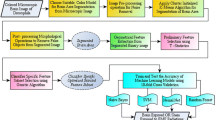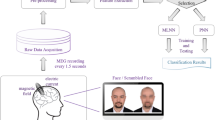Abstract
An electromagnetic field radiations (EMF) emanating from the cell phones affect the brain and other organs in living organisms. Therefore, the objective of the present study is to examine whether the EMF radiations affect the brain cells or not, using the transfer learning-based methodology. The observations made in the present study are based on our experiment with the Drosophila melanogaster. The microscopic brain-images of drosophila, (should be read as micro-images) exposed to and not exposed to the high-frequency EMF radiations were acquired for the analysis purposed. The comprehensive set of features were extracted from the micro-images in EMF-exposed and Non-exposed class drosophila using the pre-trained convolution neural networks (CNNs). Further, the support Vector Machine (SVM) has been used to find an optimal hyperplane in higher dimensional feature space which separates the feature representations of the micro-images from both the classes. The % accuracy of SVM in classifying the features extracted from the micro-images from both the classes using the pre-trained VGG19 network is 87.3% for the 5-fold cross-validation. The discrimination in feature sets extracted from the micro-images signifies that the EMF radiations have affected the drosophila brain cells. Experimental results reveal that the prolonged exposure to EMF radiations might have affected the drosophila brain which approves the assumed hypothesis.









Similar content being viewed by others
References
Adebayo EA, Adeeyo AO, Ogundiran MA, Olabisi O (2018) Bio-physical effects of radiofrequency electromagnetic radiation (RF-EMR) on blood parameters, spermatozoa, liver, kidney and heart of albino rats. J King Saud Univ Sci 31(4):813–821
Banik PP, Saha R, Kim K (2020) An automatic nucleus segmentation and CNN model-based classification method of white blood cell. Expert Syst Appl 149:113211. https://doi.org/10.1016/j.eswa.2020.113211
Borjali A, Chen AF, Muratoglu OK, Morid MA, Varadarajan KM (2020) Detecting total hip replacement prosthesis design on plain radiographs using deep convolutional neural network. J Orthop Res 38(7):1465–1471. https://doi.org/10.1002/jor.24617
Chowdhary CL, Acharjya DP (2017) Clustering algorithm in Possibilistic exponential fuzzy C-mean segmenting medical images. J Biomimetics Biomater Biomed Eng 30:12–23. https://doi.org/10.4028/www.scientific.net/jbbbe.30.12
Chowdhary CL, Acharjya DP (2018) Segmentation of mammograms using a novel intuitionistic Possibilistic fuzzy C-mean clustering algorithm. In: Panigrahi B, Hoda M, Sharma V, Goel S (eds) Nature inspired computing. Advances in intelligent systems and computing, vol 652. Springer, Singapore. https://doi.org/10.1007/978-981-10-6747-1_9
Dawud AM, Yurtkan K, Oztoprak H (2019) Application of deep learning in neuroradiology: brain haemorrhage classification using transfer learning. Comput Intell Neurosci 2019:4629859, 12 pages. https://doi.org/10.1155/2019/4629859
Deng J, Dong W, Socher R, Li L-J, Li K, Fei-Fei L (2009) Imagenet: a large-scale hierarchical image database. In: 2009 IEEE Conference on Computer Vision and Pattern Recognition. IEEE, Miami, pp 248–255
Dhungel N, Carneiro G, Bradley AP (2015) Deep learning and structured prediction for the segmentation of mass in mammograms. In: International Conference on Medical Image Computing and Computer-Assisted Intervention. Springer, Cham, pp 605–612
Gao Z, Wang L, Member S, Zhou L, Member S, Zhang J (2016) HEp-2 cell image classification with deep convolutional neural networks. IEEE J Biomed Health Inf 21(2):416–428. https://doi.org/10.1109/JBHI.2016.2526603
Harangi B (2018) Skin lesion classification with ensembles of deep convolutional neural networks. J Biomed Inform 86:25–32. https://doi.org/10.1016/j.jbi.2018.08.006
He K, Zhang X, Ren S, Sun J (2016) Deep residual learning for image recognition, IEEE conference on computer vision and pattern recognition (CVPR), Las Vegas, NV, 2016, pp. 770–778. https://doi.org/10.1109/CVPR.2016.90.
Huang G, Liu Z, Van Der Maaten L, Weinberger KQ (2017) Densely connected convolutional networks. IEEE Conference on Computer Vision and Pattern Recognition (CVPR), Honolulu, HI, 2017, pp. 2261–2269. https://doi.org/10.1109/CVPR.2017.243.
Iqbal S, Ghani MU, Saba T, Rehman A (2018) Brain tumor segmentation in multi-spectral MRI using convolutional neural networks (CNN). Microsc Res Tech 81(4):419–427. https://doi.org/10.1002/jemt.22994
Jeong Y et al (2016) 1950 MHz electromagnetic fields ameliorate Aβ pathology in Alzheimer’s disease mice. Curr Alzheimer Res 12(5):481–492
Khan S, Islam N, Jan Z, Ud I, Rodrigues JJPC (2019) A novel deep learning-based framework for the detection and classification of breast cancer using transfer learning. Pattern Recogn Lett 125:1–6. https://doi.org/10.1016/j.patrec.2019.03.022
Khurana VG, Teo C, Kundi M, Hardell L, Carlberg M (2009) Cell phones and brain tumors: a review including the long-term epidemiologic data. Surg Neurol 72(3):205–214
Kim JH, Lee JK, Kim HG, Kim KB, Kim HR (2019) Possible effects of radiofrequency electromagnetic field exposure on central nerve system. Biomol Ther 27(3):265–275
Kishore K, Venkateshu KV, Sridevi NS (2019) Effect of 1800–2100 MHz electromagnetic radiation on learning-memory and hippocampal morphology in Swiss albino mice. J Clin Diagn Res 13(2):14–17
Liu TYA, Ting DSW, Yi PH (2020) Deep learning and transfer learning for optic disc laterality detection: implications for machine learning in Neuro-ophthalmology. J Neuroophthalmol 40(2):178–184. https://doi.org/10.1097/WNO.0000000000000827
Lopes UK, Valiati JF (2017) Pre-trained convolutional neural networks as feature extractors for tuberculosis detection. Comput Biol Med 89(1):135–143. https://doi.org/10.1016/j.compbiomed.2017.08.001
Mausset-Bonnefont AL, Hirbec H, Bonnefont X, Privat A, Vignon J, De Sèze R (2004) Acute exposure to GSM 900-MHz electromagnetic fields induces glial reactivity and biochemical modifications in the rat brain. Neurobiol Dis 17(3):445–454
Morgan LL, Miller AB, Sasco A, Davis DL (2015) Mobile phone radiation causes brain tumors and should be classified as a probable human carcinogen (2A) (review). Int J Oncol 46(5):1865–1871
Okatan DO, Okatan AE, Hancı H, Demir S, Yaman SO, Odacı SCE (2018) Effects of 900-MHz electromagnetic fields exposure throughout middle/late adolescence on the kidney morphology and biochemistry of the female rat. Toxicol Ind Health 34(10):693–702
Ouadah NS, Lecomte A, Robidel F, Olsson A, Deltour I, Schüz J, Blazy K, Villégier AS (2018) Possible effects of radiofrequency electromagnetic fields on in vivo C6 brain tumors in Wistar rats. J Neuro-Oncol 140(3):539–546. https://doi.org/10.1007/s11060-018-03012-y
Pandey UB, Nichols CD (2011) Human disease models in Drosophila melanogaster and the role of the fly in therapeutic drug discovery. Pharmacol Rev 63(2):411–436. https://doi.org/10.1124/pr.110.003293
Razavinasab M, Moazzami K, Shabani M (2014) Maternal mobile phone exposure alters intrinsic electrophysiological properties of CA1 pyramidal neurons in rat offspring. Toxicol Ind Health 32(6):968–979
Simonyan K, Zisserman A (2014) Very deep convolutional networks for large-scale image recognition. CoRR abs/1409.1556
Singh A, Singh N, Jindal T, Dutta MK (2020) A novel pilot study of automatic identification of EMF radiation effect on brain using computer vision and machine learning. Biomed Signal Process Control 57. https://doi.org/10.1016/j.bspc.2019.101821
Vapnik V (1995) The nature of statistical learning theory. Springer-Verlag, New York
Wyde ME, Horn TL, Capstick MH, Ladbury JM, Koepke G, Wilson PF, Kissling GE, Stout MD, Kuster N, Melnick RL, Gauger J, Bucher JR, McCormick DL (2018) Effect of cell phone radiofrequency radiation on body temperature in rodents: pilot studies of the National Toxicology Program's reverberation chamber exposure system. Bioelectromagnetics 39(3):190–199. https://doi.org/10.1002/bem.22116
Xue Y, Bigras G, Hugh J, Ray N (2019) Training convolutional neural networks and compressed sensing end-to-end for microscopy cell detection. IEEE Trans Med Imaging 38(11):2632–2641. https://doi.org/10.1109/TMI.2019.2907093
Author information
Authors and Affiliations
Corresponding author
Ethics declarations
Declaration of conflicting interests
The authors declared no potential conflicts of interest concerning the research, authorship, and/or publication of this article.
Ethical clearance
In our knowledge, as per the Indian laws, working with Drosophila melanogaster, does not requires ethical clearance.
Additional information
Publisher’s note
Springer Nature remains neutral with regard to jurisdictional claims in published maps and institutional affiliations.
Rights and permissions
About this article
Cite this article
Maurya, R., Singh, N., Jindal, T. et al. Computer-aided automatic transfer learning based approach for analysing the effect of high-frequency EMF radiation on brain. Multimed Tools Appl 81, 13713–13729 (2022). https://doi.org/10.1007/s11042-020-10204-0
Received:
Revised:
Accepted:
Published:
Issue Date:
DOI: https://doi.org/10.1007/s11042-020-10204-0




